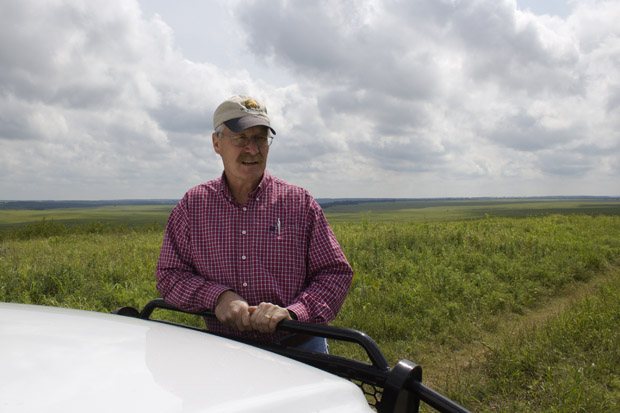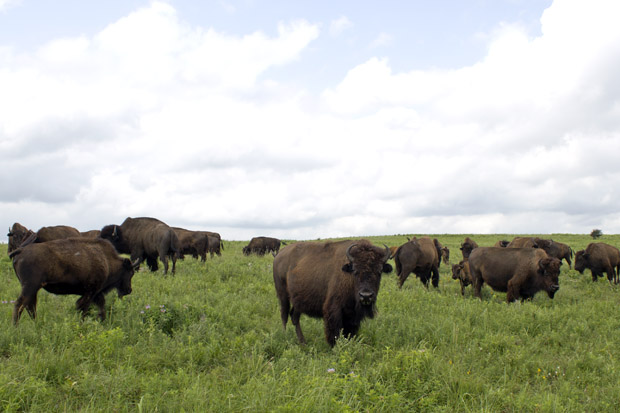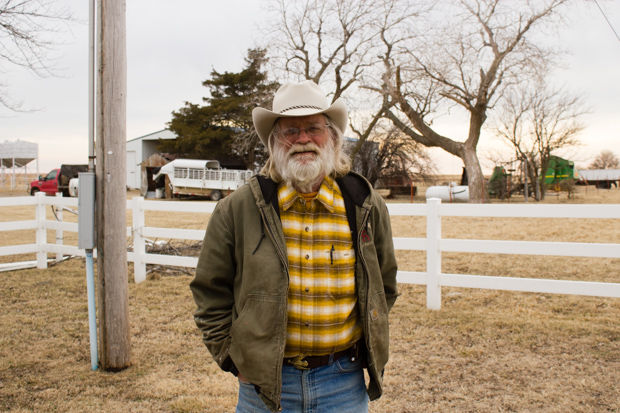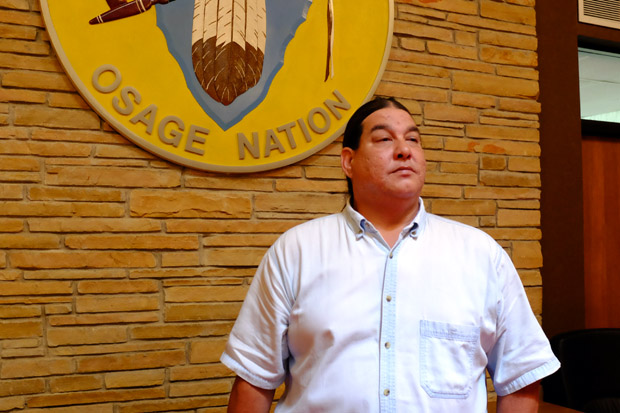
Bob Hamilton, director of the Tallgrass Prairie Preserve near Pawhuska, Okla.
Joe Wertz / StateImpact Oklahoma


Bob Hamilton, director of the Tallgrass Prairie Preserve near Pawhuska, Okla.
Joe Wertz / StateImpact Oklahoma

Joe Wertz / StateImpact Oklahoma
Bob Hamilton, director of the Tallgrass Prairie Preserve near Pawhuska, Okla.
Oklahoma is moving up the national ranks in wind-generated electricity. But as wind farms expand into northeastern Oklahoma, developers are facing a team of unlikely allies: oil interests and environmentalists.
Wind farm developers encounter opposition wherever projects are planned, but the debate in Oklahoma is perhaps most magnified in Osage County, where there’s a confluence of money, government and prairie politics.
Wind energy is becoming a big deal in Oklahoma. Last year, this state was the country’s fourth-largest wind power producer, data from the U.S. Energy Information Agency show. And while many Oklahomans are excited about the promises of wind energy — fewer carbon emissions and regular royalty checks for leased land, to name a few — the industry is facing entrenched resistance.
Wind farms are a common sight in western Oklahoma, but the industry is new to northeastern Oklahoma. Developers say the wind here is good, and this region is closer, geographically, to electrical infrastructure, which makes it cheaper to get wind power to the grid.

Joe Wertz / StateImpact Oklahoma
Bison on the Tallgrass Prairie Preserve near Pawhuska, Okla.
The Nature Conservancy is a high-profile national environmental organization that has a mission, in its own words, to protect “ecologically important lands and waters for nature and people,” a mission that would seem to align with wind energy.
The Conservancy owns the Tallgrass Prairie Preserve near Pawhuska in Osage County. The 40,000-acre preserve is one of the few remaining swaths of tallgrass prairie, which used to encompass 140 million acres across 14 states and was one of the continent’s largest ecosystems. Today, less than 5 percent of the grassland remains in southern Kansas and northern Oklahoma.
“Unfortunately, it’s our most highly impacted ecosystem type in North America,” says Bob Hamilton, the preserve’s director. “Even more highly impacted, percentage-wise, than the rainforest.”
The wildlife the preserve is working to protect, especially grouse like the greater prairie chicken, need wide open spaces to thrive.
“Natural selection has removed those chickens that have been — especially the females — that have been foolish enough to nest too close to a vertical object, and they’ve been nabbed by owls and hawks,” Hamilton says.
The little tallgrass prairie that remains in Oklahoma has survived because it’s rocky and elevated above the plain, which, historically, made it hard for farmers to plow. But that elevation has attracted interest from wind developers, which is why Hamilton says the Conservancy is fighting to keep TradeWind Energy’s 16,000-acre Mustang Run project from breaking ground near the preserve.
“It’s a real estate issue, Hamilton says. “Location, location, location. Where you put industrial wind development can be a tremendously critical decision, especially if you’re talking about at-risk species and ecosystems that are at risk.”
TradeWind’s director of project development, Aaron Weigel, says the Kansas-based company has worked to minimize Mustang Run’s environmental impact and is particularly attuned to the concerns of the Conservancy’s conservationists.
But he says a lot of the anti-wind energy sentiment in Osage County is the same brand of not-in-my-back-yard “NIMBYism” that accompanies any industrial development.
“That’s the playbook,” Weigel says. “Play up the fears of opposing locals, do everything you can to grind the process to a halt, and scare off investors in hopes that the project will stall and leave.”
In May, the Osage County Board of Adjustment denied TradeWind a conditional use permit for its Mustang Run project. Landowner and environmental concerns were among the reasons cited for denying the permit. TradeWind is fighting the permit denial in court.
During the 2014 legislative session, Sen. President Pro Tempore Brian Bingman, R-Sapulpa, authored a measure that would have placed a temporary moratorium on wind development in northeastern Oklahoma. The bill stalled, but Bingman asked the Oklahoma Corporation Commission to consider new statewide rules and regulations for the wind industry.
That process has just started, but local and state officials are wrestling with a key question: Where do one person’s property rights end, and another’s begin?

Joe Wertz / StateImpact Oklahoma
Joe Bush, owner of a ranch near Shidler, Okla., has signed agreements to lease land for two wind farms.
Frank Robson is one of the loudest anti-wind energy voices in Oklahoma. Robson, a commercial real estate developer in Claremore, has been fighting to keep a 59-turbine project from being built near his ranch near Centralia in northeastern Oklahoma’s Craig County.
While Robson doesn’t own land there, he sees Osage County as a front line in a broader war with wind developers. Effects on wildlife top Robson’s complaints against the wind industry, and he doesn’t shy away from admitting he doesn’t want a wind turbine within sight of his backyard.
“Most people don’t move to the country to have an industrial unit right next to their house,” Robson says. “How would you like to have a 495-foot turbine that goes whoosh, whoosh, whoosh, whoosh and never shuts down?”
But many landowners, like Joe Bush, do want wind turbines in their back yards. Bush has leased land to TradeWind for the Mustang Run project and the Osage Wind project, which has already broken ground. To Bush, the line between property owners is clear.
“Stay on your side of the fence,” he says. “That’s not how we do things in America. It’s capitalism, it’s America. Private property is our heritage.”

Joe Wertz / StateImpact Oklahoma
Everett Waller, chairman of the Osage Nation Minerals Council.
The Osage Nation has objected to wind-energy projects on the grounds that construction could unearth and disturb native remains and artifacts, and that spinning turbine blades could kill eagles. But there’s another element at work here: oil.
Members of the Osage Nation own most of the mineral rights in Osage County. The council that represents those interests is worried that wind farms — their large footprints as well as their power lines and associated electrical equipment — could interfere with oil and gas development.
“The site is the problem,” says Everett Waller. “It’s not the alternate energy or the wind energy, anything of the fact. I have a job as chairman of the Minerals Council to protect my shareholders. This is a business. We’re in the oil business.”